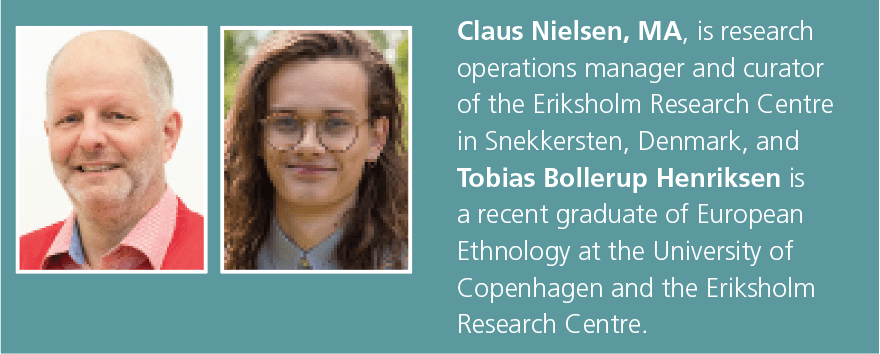Tech Topic | November 2021 Hearing Review
By Claus Nielsen, MA, and Tobias Bollerup Henriksen
For decades, feedback and occlusion had posed huge problems for hearing aid users. Today, technical advances have nearly consigned these side-effects to history.
This is the third of five articles, all based on over 40 years of working with and soliciting reactions from hearing aid wearers during studies at Eriksholm Research Centre in Denmark. In the first article we looked at how sound quality has improved from a user standpoint,1 and the second article demonstrated, in large part, why it’s the accentuation of more trivial everyday activities that can define the immense impact of better hearing.2
In the present article we focus on two themes: 1) Acoustic feedback and the challenge of solving this age-old problem with hearing aids, as well as how users have perceived the different algorithms and solutions used, and 2) Occlusion problems and how users experienced the “occlusion effect” in addition to how the problem was addressed—and has now almost disappeared. The information and anecdotes reported below are from test subjects collected over 40+ years. Further, we supplement this review with comments from colleagues at Oticon and Eriksholm.
Acoustic Feedback: Are You Whistling?
“After wearing the hearing aids for a short time, I was asked to turn down the volume due to whistling. This happened several times, which caused me to lose the urge to be a hearing aid user for a while and the devices ended up in the drawer as [the hearing aid] became too weak when I had to turn down the volume.” —1984, female
“I have had increasing problems over the last 6 months with acoustic feedback. It is not always possible for me to hear it, and it naturally presents a problem both for my surroundings and for myself.” —2000, male, 59 years
Acoustic feedback/whistling was for many years a prominent side effect of using hearing aids. As shown above, there were several problems. First, it was exceedingly difficult to provide the necessary amplification, particularly for people with severe and profound hearing losses, without feedback problems. The whistling sound is usually in the higher frequencies and is, therefore, often inaudible to the wearer of the hearing aid—but very audible to people standing within earshot. In 2000, Oticon worked with a research company to conduct a market investigation about hearing aid use (Lønberg A. Adapto–Den autoriserede biografi. Oticon, 2002). Of note, 75% of all hearing aid users experienced acoustic feedback daily, indicating it was prominent and a solution was desparately needed.
In 1990, the first feedback suppression system was launched by Danavox. The system was developed for power hearing aids used by people with severe to profound hearing losses. The system used a control noise signal, inaudible to the user, inserted by the hearing aid. When the control signal reached the microphone of the hearing aid, the amplification was adjusted until the feedback stopped. The system worked but never was a huge commercial success.3
In 2000, Oticon worked on an anti-feedback system. Several methods were considered and a system was developed for removal of the feedback echo. The system worked well if there was no mathematical link between the signal entering the microphone and the signal exiting the receiver. In hearing aids, there is a strong mathematical link between the incoming and the amplified signal. When the system was exposed to an incoming signal with a high resemblance to hearing aid feedback, it was attenuated—even though it may not have been acoustic feedback. Problematic signals included bells, flutes, violins, and other instruments. The anti-feedback system was launched in the Adapto hearing aid in 2001. Here is note from an audiology technician in 2002 on a user of this system:
“[Test subject, 43 old man] hears funny sound effects—especially the jingle used to introduce traffic information when he and his wife are on the highway to Copenhagen.” [The anti-feedback system kicked in because the jingle was mistaken for acoustic feedback.]
“I am now ready to say a little bit about how I perceive the new Adapto hearing aids. The tendency to whistle is obvious, especially when an ambulance with sirens is passing by on the street.” —2003, female, 37 years. [The ambulance siren triggered the system to make erroneous adjustments.]
Comments like these were taken extremely seriously. To improve the system, many resources were used to identify the situations and sounds that triggered these erroneous adjustments. Each time the situations or sounds were identified, the method behind the anti-feedback system was altered. It took 4 years to develop this first system, and later alterations resulted in quite a comprehensive system—using half of the processing power in the chip!
Development of a new anti-feedback system started around 2010. By then, technology had progressed and it was possible to revisit methods which had been discarded during the development of the first system. One idea was to alter the signal from the microphone a tiny bit with regard to frequency. When this was accomplished, there was no longer a mathematical link between the incoming and amplified signals. One benefit of this method is that it is almost inaudible to the user; only certain types of music and a few musical instruments did not sound as desired. Performing musicians commented on this, and other methods to supplement frequency shifting were explored. For example, one method involved switching off for a very short period the amplification in the discreet frequency range where feedback occurred. The amplification in the rest of the spectral response was untouched. Today both systems can be used to fight acoustic feedback.
Comparisons of feedback systems and hearing aid fitting procedures of the 1990s with those of today is essentially like night and day. In 2021, for example, Oticon More features “Optimal Gain, Open Fitting, No Feedback.”
Occlusion and Own-Voice Complaints
For many years acoustic feedback could only be addressed by lowering the amplification and/or using tight/closed earmolds to avoid sound leakage. These closed earmolds led to another prominent side effect: occlusion. When the user is speaking, their own voice is conducted and trapped in the closed ear canal, resulting in a change in the sound of their own voice. Typically the altered sound is described as being louder, boomy, hollow, or like listening inside a barrel. A common secondary effect is that users may lower their voice while speaking, because it sounds too loud to them. In extreme cases, people around them notice they are talking softer.
In 2003, a focus group was conducted at Eriksholm. The theme was how the hearing user experiences their own voice while using hearing aids.
“When I get these molds into my ears, I feel like I am really locked inside a cheese bell. Your own voice becomes hollow and strange.” —2003, female, 64 years
“I remember my message to the audiologist. Well, I do not feel my voice is coming out, that is, it stays here inside my head, or it stays around me, it does not come away, it does not let go. I talk with an echo all the time. It’s incredibly annoying.” —2003, male, 47 years
In 2000, MarkeTrak reported on and ranked the top reasons why people were not using their hearing aids.4 Out of 32 reasons listed, lack of benefit was #1. Reason #8 was “Poor sound quality–I can’t stand the sound of my own voice,” and #11 was “Acoustic feedback.”
The only way to solve occlusion 20+ years ago was to drill a ventilation channel in the earmold. However, as the vent becomes larger, so does the opportunity for acoustic feedback. During the development of the first anti-feedback system at Oticon, several ideas on how they should be implemented and used audiologically were discussed. The now-obvious solution was to enable more amplification and thus be able to fit more severe hearing losses. Dragan Gusatovic, a clinical audiologist at Oticon, remembers:
“It was our boss, Jes Olsen [then Senior Director of Business and Product Development], who said: ‘Now I would like to test these hearing aids with some molds with really large ventilation—4 mm and above. In order to designate an earmold to be open or for a fitting to be open, we need ventilation of 4 mm or more.’ And then we tried it out, and it actually worked very well. So, from there things developed quickly, and we finally started to be able to achieve hearing aid fittings with open molds.”
Olsen had to fight for the idea because the developers initially did not see the point. The anti-feedback system was then tailored to enable open hearing aid fittings without feedback and occlusion. More tests were conducted with a positive result, and it was finally decided to introduce the idea in the Adapto hearing aid in 2001.
“I talk louder because my voice sounds more natural/lower. Before it sounded unnaturally loud, which made me talk softer. This is probably to the great joy of my [conversation partners], as I have often been told that I speak too soft.” —2002, female Adapto wearer, 36 years
Of course, as time progressed, so too did technological advances, and open fittings became increasingly popular. In 2006, a new style of hearing aid replaced traditional BTE earmold and tubing with a thin wire connected to a receiver, heralding the arrival of receiver-in-the-canal (RIC) hearing aids. These devices also greatly benefitted from the anti-feedback and occlusion systems that preceded them.

CORRESPONDENCE can be addressed to Claus Nielsen at: [email protected].
Citation for this article: Nielsen C, Henriksen TB. 40 years of consumer comments: Making hearing aid feedback and occlusion past history. Hearing Review. 2021;28(11):28-30.
References
- Nielsen C, Henriksen TB. 40 years of sound processing as described by hearing aid users. Hearing Review. 2021;28(6):12-13.
- Nielsen C, Henriksen TB. The ‘good life’: What 40 years of consumer comments suggest about hearing aid use. Hearing Review. 2021;28(9):28-31.
- Bisgaard N. DFS–A new solution for suppression of feedback in hearing instruments. In: Jensen JH, ed. Presbyacisus and Other Age-related Aspects–Proceedings of the Danavox Symposium 14. Danavox Jubilee Foundation; 1990.
- Kochkin S. MarkeTrak V: “Why my hearing aids are in the drawer:” The consumers’ perspective. Hear Jour. 2000;53(2):34-41.





